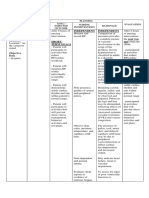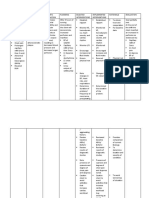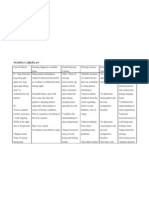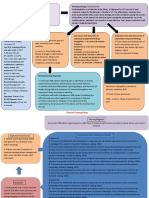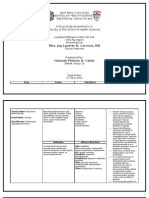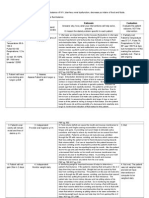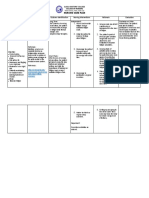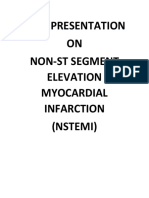NCP Angina Coronary Artery Disease
NCP Angina Coronary Artery Disease
Uploaded by
Ron Batacan De LeonCopyright:
Available Formats
NCP Angina Coronary Artery Disease
NCP Angina Coronary Artery Disease
Uploaded by
Ron Batacan De LeonOriginal Description:
Copyright
Available Formats
Share this document
Did you find this document useful?
Is this content inappropriate?
Copyright:
Available Formats
NCP Angina Coronary Artery Disease
NCP Angina Coronary Artery Disease
Uploaded by
Ron Batacan De LeonCopyright:
Available Formats
NCP Angina Coronary Artery Disease
The classic symptom of coronary artery disease (CAD) is anginapain caused by loss of oxygen and nutrients to the myocardial tissue because of inadequate coronary blood flow. In most but not all patients presenting with angina, CAD symptoms are caused by significant atherosclerosis. Unstable angina is sometimes grouped with MI under the diagnosis of acute coronary syndrome. Angina has three major forms: (1) stable (precipitated by effort, of short duration, and easily relieved), (2) unstable (longer lasting, more severe, may not be relieved by rest/nitroglycerin; may also be new onset of pain with exertion or recent acceleration in severity of pain), and (3) variant (chest pain at rest with ECG changes due to coronary artery spasm). The AHCPR guidelines of May 1994 state that unstable angina is a transitory syndrome that causes significant disability and death in the United States. CARE SETTING Patients judged to be at intermediate or high likelihood of significant CAD are often hospitalized for further evaluation and therapeutic intervention. Classification of angina (provided by Canadian Cardiovascular Society Classification [CCSC]) aids in determining the risk of adverse outcomes for patients with unstable angina and, therefore, level of treatment needs. Class III angina is identified as occurring if the patient walks less than two blocks and normal activity is markedly limited, and class IV angina occurs at rest or with minimal activity and level of activity is severely limited. These two classes may require inpatient evaluation/therapeutic adjustments. RELATED CONCERNS Cardiac surgery: postoperative care Dysrhythmias Heart failure: chronic Myocardial infarction Psychosocial aspects of care Patient Assessment Database
ACTIVITY/REST May report: Sedentary lifestyle, weakness Fatigue, feeling incapacitated after exercise Chest pain with exertion or at rest Awakened by chest pain May exhibit: Exertional dyspnea CIRCULATION May report: History of heart disease, hypertension, obesity in self/family May exhibit: Tachycardia, dysrhythmias Blood pressure normal, elevated, or decreased Heart sounds: May be normal; late S4 or transient late systolic murmur (papillary muscledysfunction) may be evident during pain Moist, cool, pale skin/mucous membranes in presence of vasoconstriction EGO INTEGRITY May report: Stressors of work, family, others May exhibit: Apprehension, uneasiness FOOD/FLUID May report: Nausea, heartburn/epigastric distress with eating Diet high in cholesterol/fats, salt, caffeine, liquor May exhibit: Belching, gastric distension PAIN/DISCOMFORT May report: Substernal or anterior chest pain that may radiate to jaw, neck, shoulders, and upper extremities (to left side more than right)
Quality: Varies from transient/mild to moderate, heavy pressure, tightness, squeezing, burning Duration: Usually less than 15 min, rarely more than 30 min (average 3 min) Precipitating factors: Physical exertion or great emotion, such as anger or sexual arousal; exercise in weather extremes; or may be unpredictable and/or occur during rest or sleep in unstable angina Relieving factors: Pain may be responsive to particular relief mechanisms (e.g., rest, antianginal medications) New or ongoing chest pain that has changed in frequency, duration, character, or predictability (i.e., unstable, variant, Prinzmetals) May exhibit: Facial grimacing, placing fist over midsternum, rubbing left arm, muscle tension, restlessness Autonomic responses, e.g., tachycardia, blood pressure changes RESPIRATION May report: Dyspnea worse with exertion History of smoking May exhibit: Respirations: Increased rate/rhythm and alteration in depth TEACHING/LEARNING May report: Family history or risk factors of CAD, hypertension, stroke, diabetes, cigarette smoking, hyperlipidemia Use/misuse of cardiac, hypertensive, or OTC drugs Regular alcohol use, illicit drug use, e.g., cocaine, amphetamines
Discharge plan DRG projected mean length of inpatient stay: 3.24.2 days considerations: Alteration in medication use/therapy Assistance with homemaker/maintenance tasks Changes in physical layout of home Refer to section at end of plan for postdischarge considerations. DIAGNOSTIC STUDIES ECG: Often normal when patient at rest or when pain-free; depression of the ST segment or T wave inversion signifies ischemia. Dysrhythmias and heart block may also be present. Significant Q waves are consistent with a prior MI. 24-hour ECG monitoring (Holter): Done to see whether pain episodes correlate with or change during exercise or activity. ST depression without pain is highly indicative of ischemia. Exercise or pharmacological stress electrocardiography: Provides more diagnostic information, such as duration and level of activity attained before onset of angina. A markedly positive test is indicative of severe CAD. Note: Studies have shown stress echo studies to be more accurate in some groups than exercise stress testing alone. Cardiac enzymes (AST, CPK, CK and CK-MB; LDH and isoenzymes LD1, LD2): Usually within normal limits (WNL); elevation indicates myocardial damage. Chest x-ray: Usually normal; however, infiltrates may be present, reflecting cardiac decompensation or pulmonary complications. PCO2, potassium, and myocardial lactate: May be elevated during anginal attack (all play a role in myocardial ischemia and may perpetuate it). Serum lipids (total lipids, lipoprotein electrophoresis, and isoenzymes cholesterols [HDL, LDL, VLDL]; triglycerides; phospholipids): May be elevated (CAD risk factor).
Echocardiogram: May reveal abnormal valvular action as cause of chest pain. Nuclear imaging studies (rest or stress scan): Thallium-201: Ischemic regions appear as areas of decreased thallium uptake. MUGA: Evaluates specific and general ventricle performance, regional wall motion, and ejection fraction. Cardiac catheterization with angiography: Definitive test for CAD in patients with known ischemic disease with angina or incapacitating chest pain, in patients with cholesterolemia and familial heart disease who are experiencing chest pain, and in patients with abnormal resting ECGs. Abnormal results are present in valvular disease, altered contractility, ventricular failure, and circulatory abnormalities. Note: Ten percent of patients with unstable angina have normal-appearing coronary arteries. Ergonovine (Ergotrate) injection: On occasion, may be used for patients who have angina at rest to demonstrate hyperspastic coronary vessels. (Patients with resting angina usually experience chest pain, ST elevation, or depression and/or pronounced rise in left ventricular end-diastolic pressure [LVEDP], fall in systemic systolic pressure, and/or high-grade coronary artery narrowing. Some patients may also have severe ventricular dysrhythmias.) NURSING PRIORITIES 1. Relieve/control pain. 2. Prevent/minimize development of myocardial complications. 3. Provide information about disease process/prognosis and treatment. 4. Support patient/SO in initiating necessary lifestyle/behavioral changes. DISCHARGE GOALS 1. Achieves desired activity level; meets self-care needs with minimal or no pain. 2. Free of complications. 3. Disease process/prognosis and therapeutic regimen understood.
4. Participating in treatment program, behavioral changes. 5. Plan in place to meet needs after discharge.
You might also like
- Nursing Care Plan For Palliative Care Nursing NotesDocument2 pagesNursing Care Plan For Palliative Care Nursing NotesblaireNo ratings yet
- Nursing Care Plan HF FinalDocument10 pagesNursing Care Plan HF FinalCristina L. JaysonNo ratings yet
- Cva NCPDocument1 pageCva NCPxiang jinNo ratings yet
- Construction of Generator Room BOQsDocument8 pagesConstruction of Generator Room BOQsAbeerNo ratings yet
- Nursing Care Plan For Heart Failure ChronicDocument26 pagesNursing Care Plan For Heart Failure ChronicbrantNo ratings yet
- NCP AnginaDocument3 pagesNCP AnginaShie LA100% (1)
- NCPDocument8 pagesNCPryzaimaliaNo ratings yet
- NCP1 CHFDocument2 pagesNCP1 CHFapi-27015740100% (5)
- NCP Ineffective Cardiopulmonary PerfusionDocument3 pagesNCP Ineffective Cardiopulmonary PerfusionjamiemapanaoNo ratings yet
- 4th Yr. Med Cardio Module Question - Copy-1Document11 pages4th Yr. Med Cardio Module Question - Copy-1Sheda BondNo ratings yet
- Nusing CareplanDocument3 pagesNusing Careplanardec_143No ratings yet
- Ineffective Breathing Pattern Related To Acute Pain As Evidence by Increased RespirationDocument6 pagesIneffective Breathing Pattern Related To Acute Pain As Evidence by Increased RespirationCamille T. SanchezNo ratings yet
- Nursing Diagnosis For Coronary Artery Disease - Acute PainDocument2 pagesNursing Diagnosis For Coronary Artery Disease - Acute PainAngie Mandeoya100% (1)
- Nursing Care Plan For Angina Pectoris NCPDocument2 pagesNursing Care Plan For Angina Pectoris NCPkarthi karthi100% (1)
- Nursing Care PlansDocument6 pagesNursing Care PlansMichelle Danica Vicente PaswickNo ratings yet
- Assessment Nursing Diagnosis Inference Objectives Nursing Intervention Rationale EvaluationDocument10 pagesAssessment Nursing Diagnosis Inference Objectives Nursing Intervention Rationale EvaluationJobelle AcenaNo ratings yet
- CHD With NCPDocument10 pagesCHD With NCPJohanna Kirsten F. DaguioNo ratings yet
- Acute Pain Care PlanDocument1 pageAcute Pain Care Planstacie4roher4smith100% (1)
- Clinical Concept MapDocument5 pagesClinical Concept MapMj FernandezNo ratings yet
- Nursing Care Plan For Myocardial Infarction NCPDocument8 pagesNursing Care Plan For Myocardial Infarction NCPRhomyrose CampanaNo ratings yet
- CVA Impaired Physical MobilityDocument3 pagesCVA Impaired Physical MobilityJasmineNo ratings yet
- ACTIVITY 1: Nursing Care PlanDocument4 pagesACTIVITY 1: Nursing Care PlanChelsea JardelezaNo ratings yet
- NCP Risk For Bleeding 1Document9 pagesNCP Risk For Bleeding 1vonjasonbuenafeNo ratings yet
- NCP Alzheimers DiseaseDocument2 pagesNCP Alzheimers DiseaseShawn TejanoNo ratings yet
- PE Case StudyDocument5 pagesPE Case StudyMatt Joseph CabantingNo ratings yet
- Nursing DiagnosisDocument10 pagesNursing DiagnosisZaty ChaiyOkk100% (1)
- Drug StudyDocument14 pagesDrug StudyHannah Philene D. CalubNo ratings yet
- Assessment Nursing Diagnosis Desired Outcome Intervention Rationale EvaluationDocument2 pagesAssessment Nursing Diagnosis Desired Outcome Intervention Rationale EvaluationtflorenzNo ratings yet
- Nursing Care PlanDocument16 pagesNursing Care PlanMelody B. MiguelNo ratings yet
- NCP Acute PainDocument3 pagesNCP Acute PainSian Grace AsadaNo ratings yet
- Risk For Fluid ImbalanceDocument8 pagesRisk For Fluid Imbalanceapi-277522722100% (1)
- NCP Proper CholecystectomyDocument2 pagesNCP Proper CholecystectomyGail Lian SantosNo ratings yet
- NCP IschemicDocument19 pagesNCP IschemicChristina Espiña EjercitoNo ratings yet
- CroupDocument10 pagesCroupEl Justinson Puspos100% (1)
- Burn Case StudyDocument4 pagesBurn Case Studyapi-232466940No ratings yet
- Nursing Care PlanDocument13 pagesNursing Care Planyumiko0% (1)
- NCPDocument17 pagesNCPbalongetzNo ratings yet
- Nursing Care Plan For Myocardial InfarctionDocument7 pagesNursing Care Plan For Myocardial InfarctionRocelyn CristobalNo ratings yet
- Myocardial Infarction EditedDocument64 pagesMyocardial Infarction EditedRos KleinNo ratings yet
- Nstemi: How To Risk Stratify?Document32 pagesNstemi: How To Risk Stratify?dhannibernadetNo ratings yet
- Myocardial Infarction: Practice Essentials, Background, Definitions PDFDocument12 pagesMyocardial Infarction: Practice Essentials, Background, Definitions PDFMukhtar UllahNo ratings yet
- Cardiac Case Study NDDocument11 pagesCardiac Case Study NDapi-313165458No ratings yet
- Case 8 NCP (Multiple Sclerosis)Document2 pagesCase 8 NCP (Multiple Sclerosis)je-ann catedralNo ratings yet
- Assessment Explanation Planning Interventions Rationale Evaluation Subjective: Objective: STG: STGDocument11 pagesAssessment Explanation Planning Interventions Rationale Evaluation Subjective: Objective: STG: STGGrape JuiceNo ratings yet
- Assessment Diagnosis Planning Interventions Rationale Evaluation Subjective Data: Short Term Goal: Short Term GoalDocument4 pagesAssessment Diagnosis Planning Interventions Rationale Evaluation Subjective Data: Short Term Goal: Short Term GoalGiselle RomeroNo ratings yet
- Nursing Care Plan: Angeles University Foundation College of NursingDocument2 pagesNursing Care Plan: Angeles University Foundation College of NursingRey Ann PangilinanNo ratings yet
- Almoete NR23 - NCP RHD (Module 9 Cardiac)Document3 pagesAlmoete NR23 - NCP RHD (Module 9 Cardiac)Gail NamangdanNo ratings yet
- NCPDocument2 pagesNCPNichole Audrey SaavedraNo ratings yet
- Concept Map 360Document6 pagesConcept Map 360api-273469220No ratings yet
- Myocardial InfarctionDocument45 pagesMyocardial InfarctionGopal SinghNo ratings yet
- NCP For AsthmaDocument2 pagesNCP For AsthmawaadNo ratings yet
- PneumoniaDocument2 pagesPneumoniaPia MedinaNo ratings yet
- Chest Pain Care PlanDocument2 pagesChest Pain Care Planapi-545292605No ratings yet
- Mushtaq Ahmad: Running Head: REFLECTIVE LOG 1Document5 pagesMushtaq Ahmad: Running Head: REFLECTIVE LOG 1Shafiq Ur RahmanNo ratings yet
- Nursing Care Plan FinalDocument16 pagesNursing Care Plan FinalErickson OcialNo ratings yet
- Hypertensive Cardiovascular DiseaseDocument5 pagesHypertensive Cardiovascular DiseaseAna Katrina OcanaNo ratings yet
- Non-St Segment Elevation Myocardial Infarction (Nstemi)Document24 pagesNon-St Segment Elevation Myocardial Infarction (Nstemi)MHIEMHOINo ratings yet
- Ventricular Septal Defect, A Simple Guide To The Condition, Treatment And Related ConditionsFrom EverandVentricular Septal Defect, A Simple Guide To The Condition, Treatment And Related ConditionsNo ratings yet
- The Ride of Your Life: What I Learned about God, Love, and Adventure by Teaching My Son to Ride a BikeFrom EverandThe Ride of Your Life: What I Learned about God, Love, and Adventure by Teaching My Son to Ride a BikeRating: 4.5 out of 5 stars4.5/5 (2)
- Management of COPD in Primary and Secondary Care, TheFrom EverandManagement of COPD in Primary and Secondary Care, TheRating: 5 out of 5 stars5/5 (1)
- Angina PectorisDocument12 pagesAngina Pectorismardsz93% (14)
- 1221 Tools For New Toastmasters PDFDocument1 page1221 Tools For New Toastmasters PDFFlorino JenteaNo ratings yet
- Syed's Resume (2)Document1 pageSyed's Resume (2)syedjibran245No ratings yet
- Economic Survey 2017 18Document399 pagesEconomic Survey 2017 18Aman singhNo ratings yet
- Rokacet Rokacet PlusDocument11 pagesRokacet Rokacet PlusNaomie bocobzaNo ratings yet
- Mighty Midget CompleteDocument10 pagesMighty Midget CompleteBailey AplinNo ratings yet
- Budgeting: Toolkit On Budgeting by Janet Shapiro (Email)Document13 pagesBudgeting: Toolkit On Budgeting by Janet Shapiro (Email)spark4uNo ratings yet
- Surah 8 Surah Alaq (96Document13 pagesSurah 8 Surah Alaq (96arshiahassanahmedNo ratings yet
- Session 1 - Concepts of Health, Health Promotion and Health EducationDocument40 pagesSession 1 - Concepts of Health, Health Promotion and Health EducationSalna Susan AbrahamNo ratings yet
- Research On The Effect of Globalization To Cultural IdentityDocument19 pagesResearch On The Effect of Globalization To Cultural IdentityMary Grace ZamudioNo ratings yet
- Leisure ActivitiesDocument6 pagesLeisure ActivitiesPha LêNo ratings yet
- The Effect of Mental Health On The Academic Performance of Senior High Students in Pinagbuhatan High SchoolDocument2 pagesThe Effect of Mental Health On The Academic Performance of Senior High Students in Pinagbuhatan High SchoolXyril Ricaella AlvaradoNo ratings yet
- 7E'S Lesson Plan in Educ 8 Name: Grade: Course: Learning Area: Year: Quarter: School: DateDocument6 pages7E'S Lesson Plan in Educ 8 Name: Grade: Course: Learning Area: Year: Quarter: School: DatecabreraainnavictoriaNo ratings yet
- SpanishDocument2 pagesSpanishaprilfatimadNo ratings yet
- Improving ATM Security Via Face RecognitionDocument4 pagesImproving ATM Security Via Face RecognitionAkhila MarpinaNo ratings yet
- G9 TosDocument6 pagesG9 TosKemberly GamaNo ratings yet
- English Research Chapter 1Document7 pagesEnglish Research Chapter 1Rahim AhilonNo ratings yet
- Thank God I - Stories of Inspiration For Every SituationDocument313 pagesThank God I - Stories of Inspiration For Every SituationRevathi Kanduri100% (2)
- Actividades de Los Animales en Inglés - EDUCACION MAESTROSDocument25 pagesActividades de Los Animales en Inglés - EDUCACION MAESTROSMartina Distéfano HerreraNo ratings yet
- A Smile With Lots of Pain...Document2 pagesA Smile With Lots of Pain...Deepika SindoluNo ratings yet
- Limiting FactorDocument4 pagesLimiting FactorGaurav JadhavNo ratings yet
- Paul Mwiru V Hon Igeme Nathan Nabeta Samson 2 Others (Election Petition Appeal No 611) 2011 UGCA 9 (15 December 2011)Document33 pagesPaul Mwiru V Hon Igeme Nathan Nabeta Samson 2 Others (Election Petition Appeal No 611) 2011 UGCA 9 (15 December 2011)Baguma Patrick RobertNo ratings yet
- Religious Education Grade 10Document29 pagesReligious Education Grade 10SamuelNo ratings yet
- Full Text 01Document290 pagesFull Text 01Viktoriia TrostohonNo ratings yet
- Immediate Download Strategic Analytics Integrating Management Science and Strategy Martin Kunc Ebooks 2024Document62 pagesImmediate Download Strategic Analytics Integrating Management Science and Strategy Martin Kunc Ebooks 2024hdhedbdaill100% (3)
- 4th Prelim Exam in PE 6Document4 pages4th Prelim Exam in PE 6belleperez88No ratings yet
- P1377 - EvpDocument3 pagesP1377 - Evpjames riceNo ratings yet
- Sanjay Internship ReportDocument49 pagesSanjay Internship Reportnithinnick66No ratings yet
- Alea EvangeliiDocument2 pagesAlea EvangeliiEvander M. NovellNo ratings yet
- DamiensDocument5 pagesDamiensMamaNo ratings yet
